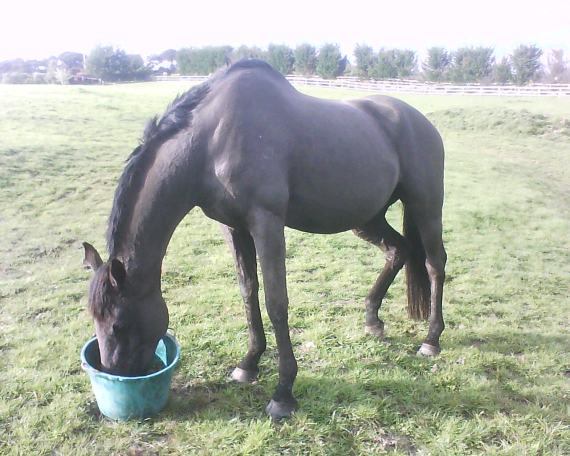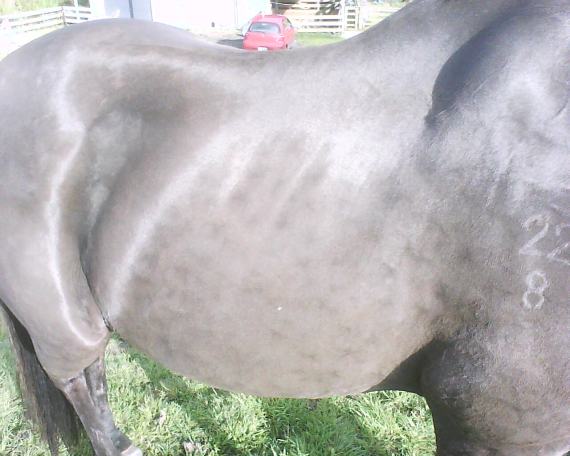So I haven’t written anything on here in a coon’s age. This is mainly inexcusable, but my excuses involve work, uni, a broken collarbone, moving house, and being a lazy good-for-nothing slacker. The latter being the true reason behind my inactivity.
Anyway, many things have happened in my absence. Rose was coming along well. We went to the Hellensville PC Novice Ribbon Day (in the Geriatrics ring… Oh Lord…) and gathered in a pretty good haul of ribbons. Rosie did her best but it was all a little much. She was totally knackered by the end.
I have now moved out to my own place+land and so have her at my own home, which is totally ideal. I can now give her her medicine day and night, as opposed once a day whenever possible and I think this is indeed improving her condition. She definitely put all her weight back on and -was- looking good.
Unfortunately, I had to go and crash my scooter into the back of a car and snap my collarbone, requiring surgery and an admonishment from the surgeon to refrain from raising my elbow any higher than my waist. As you can probably imagine this makes it rather hard to care for a horse. Rosie was fed and watered by my amazing flatmate while I was in hospital, and during the first little while after I got out. The weekend following my release she was clipped (AGAIN) and the next day my mom came out and gave her a much needed bath. However after that point, being unable to remove or replace her cover and being unable to leave her UNcovered (due to the fact that the flies around here tend to swarm upon her and drive her insane) she proceeded to live in her cover for almost 2 weeks, sweating a lot as a Cushings horse will.
This meant that when I was feeling up to it and ventured to take her cover off for the first time in a little while, I was in for a nasty surprise. Rosie now has what I originally guessed and have now confirmed (via internet research :P) to be what is basically the horsey version of dandruff. Cushings horses are prone to skin conditions due to their hair growing so long, and them sweating so much – the combination of moisture and hair is not so good. Adding this to her mud fever which in those intervening weeks got well out of hand, I was feeling rather shocked and at a complete and total loss.
I now have the situation in hand. Now that I am able, I can groom her daily. I have also gone and bought a flea comb for my cat and have been using it on her to scrap away the icky scabby stuff that is literally all over her. It is working like a dream and is actually really really good for getting the mud fever scabs off as well. Way better than fingernails! Next step, once I’ve de-scabbed her whole body is a wash with pinetarsol dandruff shampoo, and hopefully we’ll be home free!
In addition to this somewhat annoying and distressing step backward, I have attempted to take a few forward. Rose is now on 2 additional supplements which I have been trying out. Apple cider vinegar has long been claimed to be great for Cushings, I’m not 100% sure why but I think it has something to do with metabolism and immune support. I don’t know if I fully believe it, but i’ve put her on it anyway. Falloons in Dairy Flat sells jugs of apple cider vinegar mixed with manuka honey and garlic. I figured if nothing else, the garlic and manuka honey are well known to be immuno-supportive which is definitely something that she needs. I also -just- bought a massive jug of flax seed oil (which is actually linseed oil, not flax like native NZ flax…). I mainly purchased this at the urging of my mom because of its claims at supporting healthy skin, hair, and hoof growth (Rose has recently been prone to sand cracks). However it is also supposed to support the immune system and help with joint stress worries by helping with inflammation. As well as this it supposedly calms nervous animals and does various other things which lead me to believe it may have an effect on the stress response. If this is so, it could be very good for a Cushings horse!
I suppose the results will speak for themselves in a short while, but to cut a long story short – though Rose continues to be difficult and crop up with more and more annoying issues, so far I have been able to deal with them rather easily. This lets me live in hope that I can continue to manage her condition.
She is unfortunately showing the degradation in the topline said to be common to Cushings horses and so I am going to be working her a lot on the lunge (once I have healed, myself) to try and build some of that muscle back up before I get on her again.
Has anyone ever used flax seed oil, or apple cider vinegar as supplements? And did you notice any change? Also, if anyone has any tips on rebuilding a topline from the ground up, so to speak, I would be eager to hear them!
– C.

